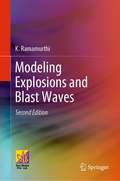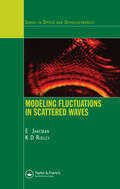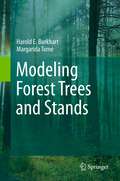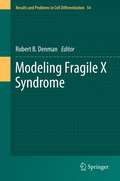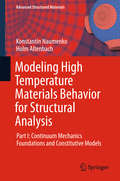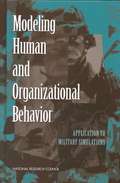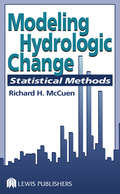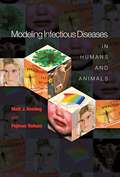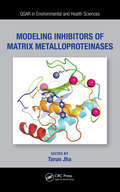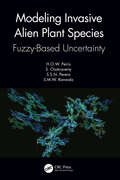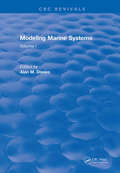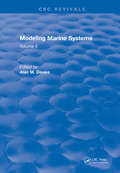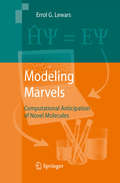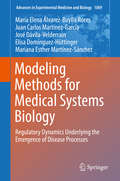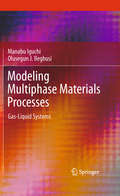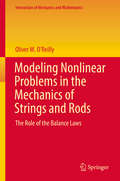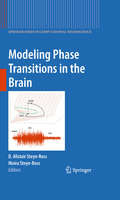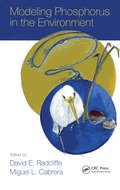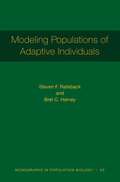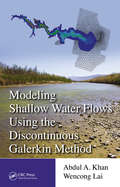- Table View
- List View
Modeling Explosions and Blast Waves
by K. RamamurthiThe book provides a concise description of the physical processes and mathematical models for explosions and formation of blast waves from explosions. The contents focus on quantitatively determining the energy released in the different types of explosions and the destructive blast waves that are generated. The contribution of flames, detonations and other physical processes to the explosion phenomenon is dealt with in detail. Gaseous and condensed phase explosions are discussed and the yield of explosions with their TNT equivalence is determined. Time scales involved in the explosion process and the scaling procedure are ascertained. Explosions over the ground, in water, and the interaction of explosions with objects are examined. In order to keep the text easily readable, the detailed derivation of the mathematical equations is given in the seven appendices at the end of the book. Case studies of various explosions are investigated and simple problems and their solutions are provided for the different topics to assist the reader in internalizing the explosion process. The book is a useful reference for professionals and academics in aeronautics, mechanical, civil and chemical engineering and for personnel working in explosive manufacture and high-energy materials, armaments, space, defense, and industrial and fire safety.
Modeling Failure and Fracture of Soft Solids and Fluids
by Konstantin VolokhThis book applies approaches of nonlinear continuum mechanics used to model fracture and failures in soft materials. Two physical observations underlie mathematical theories described in this book. First, the energy of molecular bonds is bounded and, consequently, the macroscopic strain energy must be bounded. Second, the broken bonds are diffused and, consequently, highly localized material sink takes place. The first observation allows describing material failure as the damage initiation. The second observation allows modeling cracks as damage localization and propagation. This book builds on the experiences of “Soft Matter Mechanics” by Konstantin Volokh.
Modeling Fluctuations in Scattered Waves
by E. Jakeman K. D. RidleyFluctuations in scattered waves limit the performance of imaging and remote sensing systems that operate on all wavelengths of the electromagnetic spectrum. To better understand these fluctuations, Modeling Fluctuations in Scattered Waves provides a practical guide to the phenomenology, mathematics, and simulation of non-Gaussian noise models and d
Modeling Forest Trees and Stands
by Harold E. Burkhart Margarida ToméDrawing upon a wealth of past research and results, this book provides a comprehensive summary of state-of-the-art methods for empirical modeling of forest trees and stands. It opens by describing methods for quantifying individual trees, progresses to a thorough coverage of whole-stand, size-class and individual-tree approaches for modeling forest stand dynamics, growth and yield, moves on to methods for incorporating response to silvicultural treatments and wood quality characteristics in forest growth and yield models, and concludes with a discussion on evaluating and implementing growth and yield models. Ideal for use in graduate-level forestry courses, this book also provides ready access to a plethora of reference material for researchers working in growth and yield modeling.
Modeling Fragile X Syndrome
by Robert B. DenmanIntroduction.-Probing Astrocyte Function in Fragile X Syndrome.- Neural Stem Cells.- Fragile X Mental Retardation Protein (FMRP) and the Spinal Sensory System.- The Role of the Postsynaptic Density in the Pathology of the Fragile X Syndrome.- Behavior in a Drosophila model of Fragile X.- Molecular and Genetic Analysis of the Drosophila Model of Fragile X Syndrome.- Fragile X Mental Retardation Protein and Stem Cells.- Manipulating the Fragile X Mental Retardation Proteins in the Frog.- Exploring the Zebra finch Taeniopygia gutta as a Novel Animal Model for the Speech-language Deficit of Fragile X Syndrome.- Neuroendocrine Alterations in the Fragile X Mouse.- Taking STEPs forward to understanding Fragile X Syndrome.- Fmr-1 as an Offspring Genetic and a Maternal Environmental Factor in Neurodevelopmental Disease.- Mouse Models of the Fragile X Premutation and the Fragile X Associated Tremor/Ataxia Syndrome.- Clinical Aspects of the Fragile X Syndrome.- Fragile X Syndrome: A Psychiatric Perspective.- Fragile X Syndrome and Targeted Treatment Trials.- The Fragile X-associate Tremor Ataxia Syndrome.- Vignettes: Models in Absentia.
Modeling High Temperature Materials Behavior for Structural Analysis
by Holm Altenbach Konstantin NaumenkoThis monograph presentsapproaches to characterize inelastic behavior of materials and structures athigh temperature. Starting from experimental observations, it discusses basicfeatures of inelastic phenomena including creep, plasticity, relaxation, lowcycle and thermal fatigue. The authors formulate constitutive equations to describe the inelastic responsefor the given states of stress and microstructure. They introduce evolutionequations to capture hardening, recovery, softening, ageing and damage processes. Principles of continuum mechanics and thermodynamics are presented to provide aframework for the modeling materials behavior with the aim of structuralanalysis of high-temperature engineering components.
Modeling Human and Organizational Behavior: Application To Military Simulations
by Panel on Modeling Human Behavior Command Decision Making: Representations for Military SimulationsSimulations are widely used in the military for training personnel, analyzing proposed equipment, and rehearsing missions, and these simulations need realistic models of human behavior. This book draws together a wide variety of theoretical and applied research in human behavior modeling that can be considered for use in those simulations. It covers behavior at the individual, unit, and command level. At the individual soldier level, the topics covered include attention, learning, memory, decisionmaking, perception, situation awareness, and planning. At the unit level, the focus is on command and control. The book provides short-, medium-, and long-term goals for research and development of more realistic models of human behavior.
Modeling Hydrologic Change: Statistical Methods
by Richard H. McCuenModeling hydrologic changes and predicting their impact on watersheds is a dominant concern for hydrologists and other water resource professionals, civil and environmental engineers, and urban and regional planners. As such changes continue, it becomes more essential to have the most up-to-date tools with which to perform the proper analyses and m
Modeling Infectious Diseases in Humans and Animals
by Pejman Rohani Matt J. KeelingFor epidemiologists, evolutionary biologists, and health-care professionals, real-time and predictive modeling of infectious disease is of growing importance. This book provides a timely and comprehensive introduction to the modeling of infectious diseases in humans and animals, focusing on recent developments as well as more traditional approaches.Matt Keeling and Pejman Rohani move from modeling with simple differential equations to more recent, complex models, where spatial structure, seasonal "forcing," or stochasticity influence the dynamics, and where computer simulation needs to be used to generate theory. In each of the eight chapters, they deal with a specific modeling approach or set of techniques designed to capture a particular biological factor. They illustrate the methodology used with examples from recent research literature on human and infectious disease modeling, showing how such techniques can be used in practice. Diseases considered include BSE, foot-and-mouth, HIV, measles, rubella, smallpox, and West Nile virus, among others. Particular attention is given throughout the book to the development of practical models, useful both as predictive tools and as a means to understand fundamental epidemiological processes. To emphasize this approach, the last chapter is dedicated to modeling and understanding the control of diseases through vaccination, quarantine, or culling.Comprehensive, practical introduction to infectious disease modelingBuilds from simple to complex predictive modelsModels and methodology fully supported by examples drawn from research literaturePractical models aid students' understanding of fundamental epidemiological processesFor many of the models presented, the authors provide accompanying programs written in Java, C, Fortran, and MATLABIn-depth treatment of role of modeling in understanding disease control
Modeling Inhibitors of Matrix Metalloproteinases (QSAR in Environmental and Health Sciences)
by Tarun JhaMatrix metalloproteinases (MMPs) have been established as promising biomolecular targets for novel drug design and discovery against numerous major disease conditions including various cancers, cardiovascular, neurodegenerative, inflammatory diseases, and more. This book covers various modern molecular modeling methodologies particularly related to MMP inhibitors. Included in the text are descriptions of ligand-based drug designing and structure-based drug designing modeling strategies for designing potential and target specific or selective MMPIs. This book will benefit those who are looking for an in-depth text on the design and discovery processes of novel and selective MMPIs. Features Describes modeling strategies applied to MMPs Elaborates on the designing strategies of MMPs specifically Includes in-depth analyses of related case studies Acts as a guide for medicinal chemists, not only from pharmaceutical industries, but also from academia Covers various modern molecular modeling methodologies, particularly related to MMPIs
Modeling Invasive Alien Plant Species: Fuzzy-Based Uncertainty
by S. Chakraverty H.O.W. Peiris S.S.N. Perera S.M.W. RanwalaModelling Invasive Alien Plant Species: Fuzzy Based Uncertainty presents the application of different fuzzy set theory techniques in developing risk assessment models for invasive plant species- those whose introduction and spread outside their natural range threatens local biodiversity. Invasion risk of species is expressed by biological traits which would be considered as the risk factors accompanied with uncertainty and imprecision. The book considers both quantitative and qualitative inputs in modelling the invasive risk by incorporating different mathematical models based on fuzzy set theory operators, interval methods, and fuzzy linguistic operators. The proposed models can be applied for investigating risk of invasive alien plant species in various regions and conditions. Features: Uniquely merges mathematical models with biological expressions. Presents different factor-based models as a case study on the risk of invasive alien plant species. Explains how users can perform primary-level risk assessment through fuzzy modeling techniques. Appropriate for upper-level students, researchers, and practicing professionals, this book shows how conventional approaches such as probability theory can be of limited use to solve issues of uncertainty, and how they fuzzy set theory plays a better role in understanding uncertain system dynamics, such invasive plant modelling.
Modeling Marine Systems: Volume I
by A. M. DaviesThis two-volume reference presents a series of review and research articles on advances in computing, marine physics, and remote sensing and addresses their importance to shallow sea modeling. Intended as a tribute to Dr. Norman Heaps, topics in the book reflect the range and diversity of his work, as well as his influence on international marine science. Topics discussed include numerical techniques, flow in homogenous sea regions, stratified flows, lake regimes, validation of numerical models, remote sensing as a method to collect oceanographic data at the sea surface, and bottom boundary modeling. Marine scientists actively involved in mathematical modeling and scientists who are interested in using models as tools to gain more insight and understanding of the processes they are observing will find this text useful.
Modeling Marine Systems: Volume II
by A. M. DaviesThis two-volume reference presents a series of review and research articles on advances in computing, marine physics, and remote sensing and addresses their importance to shallow sea modeling. Intended as a tribute to Dr. Norman Heaps, topics in the book reflect the range and diversity of his work, as well as his influence on international marine science. Topics discussed include numerical techniques, flow in homogenous sea regions, stratified flows, lake regimes, validation of numerical models, remote sensing as a method to collect oceanographic data at the sea surface, and bottom boundary modeling. Marine scientists actively involved in mathematical modeling and scientists who are interested in using models as tools to gain more insight and understanding of the processes they are observing will find this text useful.
Modeling Marvels
by Errol G. LewarsThe aim of this highly original book is to survey a number of chemical compounds that some chemists, theoretical and experimental, find fascinating. This is the first book to feature compounds/classes of compounds of theoretical interest that have been studied theoretically but have defied synthesis. It is hoped that this collection of idiosyncratic molecules will appeal to chemists who find the study of chemical oddities interesting and, on occasion, even rewarding.
Modeling Matter: The Chemistry of Food, Investigation Notebook
by The Lawrence Hall of ScienceNIMAC-sourced textbook
Modeling Methods for Marine Science
by David M. Glover William J. Jenkins Scott C. DoneyThis advanced textbook on modeling, data analysis and numerical techniques for marine science has been developed from a course taught by the authors for many years at the Woods Hole Oceanographic Institute. The first part covers statistics: singular value decomposition, error propagation, least squares regression, principal component analysis, time series analysis and objective interpolation. The second part deals with modeling techniques: finite differences, stability analysis and optimization. The third part describes case studies of actual ocean models of ever increasing dimensionality and complexity, starting with zero-dimensional models and finishing with three-dimensional general circulation models. Throughout the book the general principles and goals of scientific visualization are emphasized through technique and application. Ideal as a textbook for advanced students of oceanography on courses in data analysis and numerical modeling, the book is also an invaluable resource for a broad range of scientists undertaking modeling in chemical, biological, geological and physical oceanography.
Modeling Methods for Medical Systems Biology: Regulatory Dynamics Underlying the Emergence of Disease Processes (Advances in Experimental Medicine and Biology #1069)
by María Elena Álvarez-Buylla Roces Juan Carlos Martínez-García José Dávila-Velderrain Elisa Domínguez-Hüttinger Mariana Esther Martínez-SánchezThis book contributes to better understand how lifestyle modulations can effectively halt the emergence and progression of human diseases. The book will allow the reader to gain a better understanding of the mechanisms by which the environment interferes with the bio-molecular regulatory processes underlying the emergence and progression of complex diseases, such as cancer. Focusing on key and early cellular bio-molecular events giving rise to the emergence of degenerative chronic disease, it builds on previous experience on the development of multi-cellular organisms, to propose a mathematical and computer based framework that allows the reader to analyze the complex interplay between bio-molecular processes and the (micro)-environment from an integrative, mechanistic, quantitative and dynamical perspective. Taking the wealth of empirical evidence that exists it will show how to build and analyze models of core regulatory networks involved in the emergence and progression of chronic degenerative diseases, using a bottom-up approach.
Modeling Multiphase Materials Processes
by Manabu Iguchi Olusegun J. IlegbusiModeling Multiphase Materials Processes: Gas-Liquid Systems describes the methodology and application of physical and mathematical modeling to multi-phase flow phenomena in materials processing. The book focuses on systems involving gas-liquid interaction, the most prevalent in current metallurgical processes. The performance characteristics of these processes are largely dependent on transport phenomena. This volume covers the inherent characteristics that complicate the modeling of transport phenomena in such systems, including complex multiphase structure, intense turbulence, opacity of fluid, high temperature, coupled heat and mass transfer, chemical reactions in some cases, and poor wettability of the reactor walls. Also discussed are: solutions based on experimental and numerical modeling of bubbling jet systems, recent advances in the modeling of nanoscale multi-phase phenomena and multiphase flows in micro-scale and nano-scale channels and reactors. Modeling Multiphase Materials Processes: Gas-Liquid Systems will prove a valuable reference for researchers and engineers working in mathematical modeling and materials processing.
Modeling Nanoscale Imaging in Electron Microscopy
by Wolfgang Dahmen Thomas Vogt Peter BinevModeling Nanoscale Imaging in Electron Microscopy presents the recent advances that have been made using mathematical methods to resolve problems in microscopy. With improvements in hardware-based aberration software significantly expanding the nanoscale imaging capabilities of scanning transmission electron microscopes (STEM), these mathematical models can replace some labor intensive procedures used to operate and maintain STEMs. This book, the first in its field since 1998, will also cover such relevant concepts as superresolution techniques, special denoising methods, application of mathematical/statistical learning theory, and compressed sensing.
Modeling Nonlinear Problems in the Mechanics of Strings and Rods: The Role of the Balance Laws (Interaction of Mechanics and Mathematics)
by Oliver M. O'ReillyThis book presents theories of deformable elastic strings and rods and their application to broad classes of problems. Readers will gain insights into the formulation and analysis of models for mechanical and biological systems. Emphasis is placed on how the balance laws interplay with constitutive relations to form a set of governing equations. For certain classes of problems, it is shown how a balance of material momentum can play a key role in forming the equations of motion. The first half of the book is devoted to the purely mechanical theory of a string and its applications. The second half of the book is devoted to rod theories, including Euler’s theory of the elastica, Kirchhoff ’s theory of an elastic rod, and a range of Cosserat rod theories. A variety of classic and recent applications of these rod theories are examined. Two supplemental chapters, the first on continuum mechanics of three-dimensional continua and the second on methods from variational calculus, are included to provide relevant background for students.This book is suited for graduate-level courses on the dynamics of nonlinearly elastic rods and strings.
Modeling Peptide-Protein Interactions
by Ora Schueler-Furman Nir LondonThis volume covers an array of techniques available for studying peptide-protein docking and design. The book is divided into four sections: peptide binding site prediction; peptide-protein docking; prediction and design of peptide binding specificity; and the design of inhibitory peptides. The chapters in Modeling Peptide-Protein Interactions: Methods and Protocols cover topics such as the usage of ACCLUSTER and PeptiMap for peptide binding site prediction; AnchorDock and ATTRACT for blind, flexible docking of peptides to proteins; flexible peptide docking using HADDOCK and FlexPepDock; identifying loop-mediated protein-protein interactions using LoopFinder; and protein-peptide interaction design using PinaColada. Written in the highly successful Methods in Molecular Biology series format, chapters include introductions to their respective topics, lists of the necessary details for successful application of the different approaches and step-by-step, readily reproducible protocols, as well as tips on troubleshooting and avoiding known pitfalls. Cutting-edge and thorough, Modeling Peptide-Protein Interactions: Methods and Protocols provides a diverse and unified overview of this rapidly advancing field of major interest and applicability.
Modeling Phase Transitions in the Brain
by D. Alistair Steyn-Ross Moira Steyn-Ross Walter FreemanForeword by Walter J. Freeman. The induction of unconsciousness using anesthetic agents demonstrates that the cerebral cortex can operate in two very different behavioral modes: alert and responsive vs. unaware and quiescent. But the states of wakefulness and sleep are not single-neuron properties---they emerge as bulk properties of cooperating populations of neurons, with the switchover between states being similar to the physical change of phase observed when water freezes or ice melts. Some brain-state transitions, such as sleep cycling, anesthetic induction, epileptic seizure, are obvious and detected readily with a few EEG electrodes; others, such as the emergence of gamma rhythms during cognition, or the ultra-slow BOLD rhythms of relaxed free-association, are much more subtle. The unifying theme of this book is the notion that all of these bulk changes in brain behavior can be treated as phase transitions between distinct brain states. Modeling Phase Transitions in the Brain contains chapter contributions from leading researchers who apply state-space methods, network models, and biophysically-motivated continuum approaches to investigate a range of neuroscientifically relevant problems that include analysis of nonstationary EEG time-series; network topologies that limit epileptic spreading; saddle--node bifurcations for anesthesia, sleep-cycling, and the wake--sleep switch; prediction of dynamical and noise-induced spatiotemporal instabilities underlying BOLD, alpha-, and gamma-band Hopf oscillations, gap-junction-moderated Turing structures, and Hopf-Turing interactions leading to cortical waves.
Modeling Phosphorus in the Environment
by David E. Radcliffe Miguel L. CabreraDespite advances in modeling, such as graphical user interfaces, the use of GIS layers, and databases for developing input files, the approaches to modeling phosphorus (P) have not changed since their initial development in the 1980s. Current understanding of P processes has evolved and this new information needs to be incorporated into the current
Modeling Populations of Adaptive Individuals (Monographs in Population Biology #63)
by Steven F. Railsback Bret C. HarveyEcologists now recognize that the dynamics of populations, communities, and ecosystems are strongly affected by adaptive individual behaviors. Yet until now, we have lacked effective and flexible methods for modeling such dynamics. Traditional ecological models become impractical with the inclusion of behavior, and the optimization approaches of behavioral ecology cannot be used when future conditions are unpredictable due to feedbacks from the behavior of other individuals. This book provides a comprehensive introduction to state- and prediction-based theory, or SPT, a powerful new approach to modeling trade-off behaviors in contexts such as individual-based population models where feedbacks and variability make optimization impossible.Modeling Populations of Adaptive Individuals features a wealth of examples that range from highly simplified behavior models to complex population models in which individuals make adaptive trade-off decisions about habitat and activity selection in highly heterogeneous environments. Steven Railsback and Bret Harvey explain how SPT builds on key concepts from the state-based dynamic modeling theory of behavioral ecology, and how it combines explicit predictions of future conditions with approximations of a fitness measure to represent how individuals make good—not optimal—decisions that they revise as conditions change. The resulting models are realistic, testable, adaptable, and invaluable for answering fundamental questions in ecology and forecasting ecological outcomes of real-world scenarios.
Modeling Shallow Water Flows Using the Discontinuous Galerkin Method
by Abdul A. Khan Wencong LaiThis book introduces the discontinuous Galerkin (DG) method and its application to shallow water flows. The emphasis is to show details and modifications required to apply the scheme to real-world flow problems. It allows the readers to understand and develop robust and efficient computer simulation models that can be used to model flow, contaminant transport, and other factors in rivers and coastal environments. The book includes a large set of tests to illustrate the use of the model for a wide range of applications.
